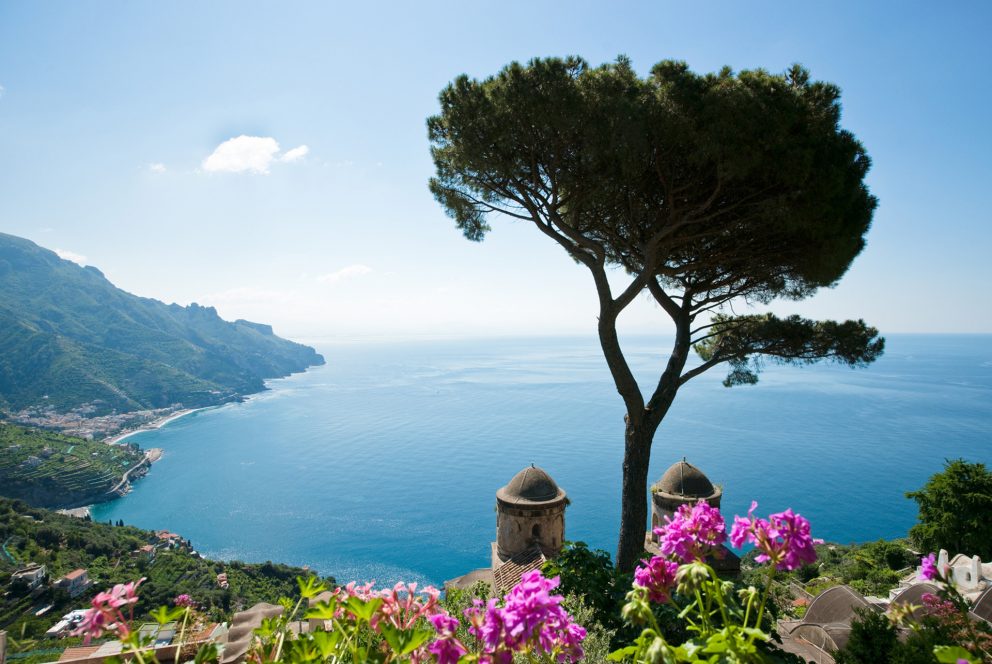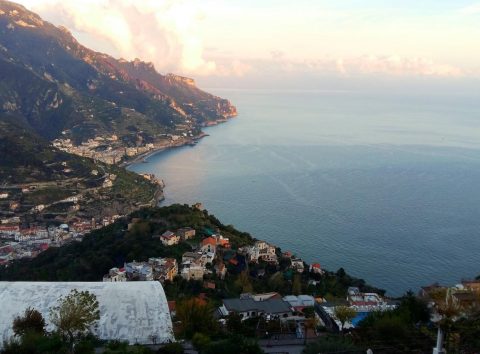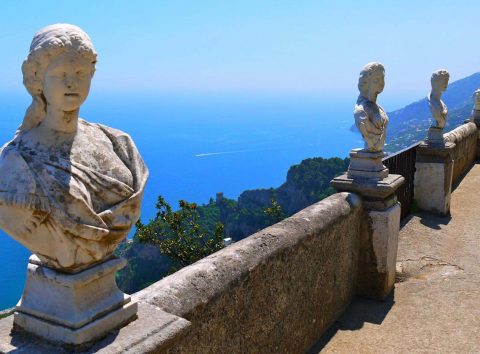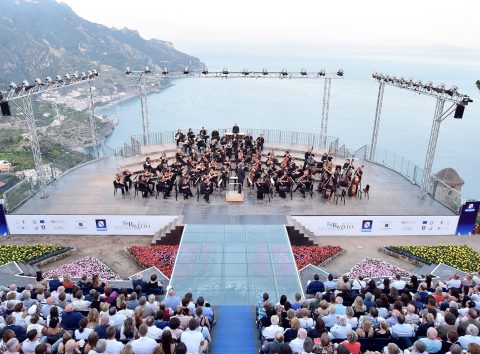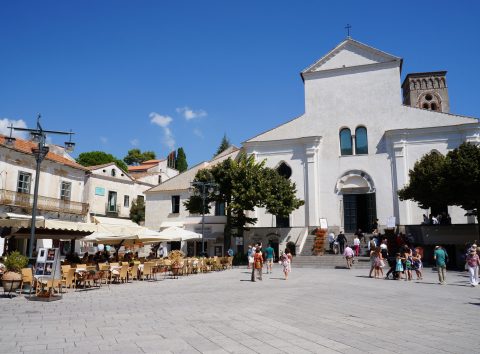Ravello "City of music"
The old medieval city, located on a plateau above Maiori and Minori, Ravello boasts a spectacular view over the Gulf of Salerno, in the course of time it has enchanted many artists, including Richard Wagner to whom is dedicated the symbol of the city ‘the Ravello Festival’.
Known worldwide for its history, its beautiful landscapes, for its precious and aristocratic monuments, the town stretches for 7 km² and has about 2506 inhabitants, called Ravellesi.
The city was built between the end of the west Roman Empire and the begining of one of the East, when the Roman aristocracy families escaped the barbarian incursions they took refuge here on the Lattari Mountains, rich in vegetation and water. Some scholars ascribe the name Ravello to a rebellion to amalfintane rules, whilst the most accredited hypothesis dates back to pre-Indo-European root "Grav" that tied at its base "karra" (stone, Cliff) would indicate the rugged nature of the territory.
Until 11th century Ravello followed the fortunes of the Duchy of Amalfi, mercantile Republic based on trade with the East Arabics and Byzantines, so in the centuries from the 11th to 14th it sustained a big rise with the development of its aristocracy backed by the Normans and the development of a very populated urban core with the birth of palaces, shops, churches and gardens. After the death of Robert of Anjou, however, began a series of struggles between the Angevin and Durazzeschi that reduced the wealthiest cities of the Duchy to wilderness, abandoned by the nobility who left for Naples. At the time of the "Struggle", "Ravello" was affected by a process of ruralizzazione, although it retained the old medieval structure and the noble mansions which were saved from noble families.
In the 16th century, the town went through a process of decadence, due to earthquakes and famines which marked it, and, at least until the 18th century its history was related to that of the Kingdom of Naples. To regain its glory the town had to wait until the second half of the nineteenth century, when it was rediscovered and became a destination for artists and visitors who admired the natural and artistic beauty calling it a place of rejuvenation of the spirit. Although small, Ravello is visited by tourists from all over the world who admire its many beaties, such as its monuments overlooking the coast contributing to form its unique beauties. Of great historical and architectural importance is, of course, the Cathedral of Ravello, dating back to the 11th century and with the characteristic bronze tiles portal, by Barisano of Trani (1179). Inside the structure is characterized by two Ambos in inlayed marble work, to the right that of the Gospel, by Nicolò di Bartolomeo from Foggia (1272), and to left one of Byzantine origin, donated by the second Bishop of Ravello. In the 17th century chapel rests the ampoule with the blood of San Pantaleone, a relic kept there since the 12th century. Of equal importance is also the attached Museum, with works like the bust of Sigilgaita Rufolo, made by Nicolò di Bartolomeo from Foggia.
One can also visit numerous churches of historical importance, such as the Church of Santa Maria a Gradillo, the Basilica with its three apses dating back to the 11th century. Built in the 12th century was the Church of San Giovanni del Toro, with a pulpit dating back to the 1200, enriched by Persian basins and frescoes of the ‘300 in its crypt. Its key feature is the three apses with entwined domes and arches. Then there is the Church of San Francesco, a building of Gothic origin, but rebuilt in the 18th century, the Church of Santa Chiara, dating back to the 13th century, but renovated in the 18th century and the Church of the Annunziata, known especially for its two characteristic domes.
Ravello is also renowned for its mansions, testimony of its past, wealth and splendour, as Villa Rufolo, a collection of buildings dating back to the 13th and 14th centuries, with Islamic influences. The villa also contains an archaeological Antiquarium.No less remarkable is Villa Cimbrone, eclectic building with reuse of ancient fragments and the famous Belvedere. The Museum of coral Camo, with authentic precious pieces dating back to the 18th century such as a patchbox encrusted in cameos. And the historic Sanctuary of Santi Cosma e Damiano, dating back to the 14th century. Many artists have visited Ravello and have praised its beauty, in addition to Wagner in the second half of the 19th century, other illustrious names were attracted by the charm of the place, like Giuseppe Verdi, Arturo Toscanini, Virginia Woolf, André Gide, Paul Valéry, Greta Garbo, Eduardo de Filippo, Gina Lollobrigida, Totò, Federico Fellini, John Kennedy, Vittorio Gassman, Romy Schneider and many others.
Currently the town has a standard of living among the highest in the Campania region, and hosts annually, the famous Ravello Festival, an event that lasts several months, devoted to music, dance, cinema and all other major artistic representations. The Festival, which is of great value and makes the name of Ravello known to all the countries of the world, takes place in Villa Rufolo, which inspired the composer Richard Wagner, to whom is dedicated the event to his Parsifal. If such Festival is the most linked to the name of Ravello, in the city, however, there are also other events, like the very famous he feast of San Pantaleone, held on 27 July, the feast of our Lady of sorrows of Torello, which is celebrated the second Sunday of September and concludes with an impressive fireworks display. The enviable location of Ravello has allowed to cultivate high-quality grapes that, alongside the lemon and orange groves, represent the cutting edge of the culinary repertoire of Ravello. The quality of the wine produced in Ravello has abtained alongside those produced in Furore and Tramonti, the d.o.c. denomination, in order to enhance the wine production of the Amalfi coast. Whites, reds and rosés are produced from local wineries and marketed worldwide. The same wine, combined with the typical dishes of the Amalfi coast, which combine skillfully sea products with those of peasant cuisine can be tasted in the restaurants of Ravello, overlooking the splendid scenery of the "Divina costiera". Its crafts also make Ravello a desired goal for tourists from all over the world, of great value is the workmanship of coral, which is also a museum that preserves precious artefacts dating back to remote times. Also praiseworthy is the craftsmanship of pottery that has its epicentre in Vietri sul Mare.
Useful information:
How to reach Ravello:
Distance from Sorrento: 38 km
by car/moto: following the S.S. 163 towards Amalfi, then taking the s. 373 up to Ravello.
by bus: Sita buses towards Ravello.
Useful Numbers:
Municipal police: tel 089 857498
Taxi: 089 857664
Posy office: Via Vescovado 3, tel 089 858161

